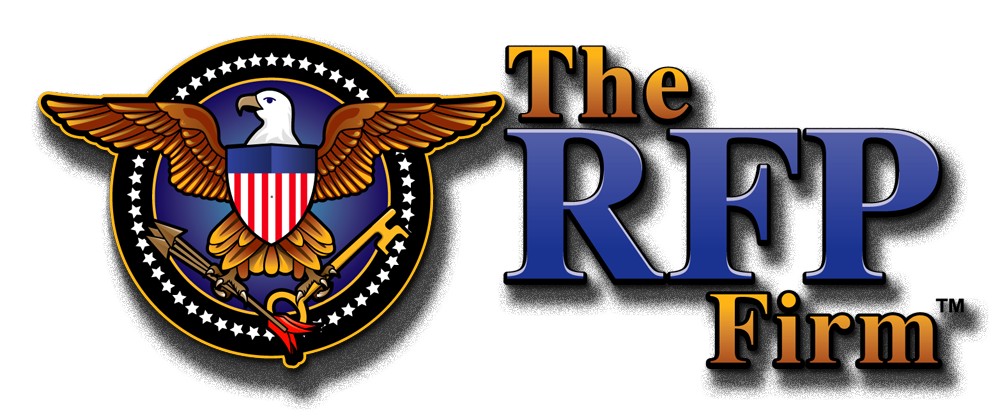Blog
Government & Commercial Proposal Writing Services
 The RFP Firm is expert at writing proposals in Response to Federal and State Government RFP Solicitations that will give you a Competitive Advantage over your competition.
The RFP Firm is expert at writing proposals in Response to Federal and State Government RFP Solicitations that will give you a Competitive Advantage over your competition.


Proposal Writing Services , RFP Proposal Consulting, Government RFP writing
Government RFP Proposal Writing Services
Government & Commercial Proposal Writing Services
 The RFP Firm is expert at writing proposals in Response to Federal and State Government RFP Solicitations that will give you a Competitive Advantage over your competition.
The RFP Firm is expert at writing proposals in Response to Federal and State Government RFP Solicitations that will give you a Competitive Advantage over your competition.

A government RFP (Request for Proposal) is a document issued by a government agency to solicit proposals from qualified contractors to provide either products or services. The purpose of the solicitation process is to receive proposals from multiple vendors at the same time in order to evaluate one against another to determine which company is the most qualified and provide the best value for the cost while meeting the government’s goals and objectives.
The selection process is most often a balance between the vendor’s qualifications, technical approach, past experience accomplishing similar work, and the bid price with emphasis placed on each of these factors based on which is deemed more important than another. Typically, they will use a scoring system that assigns points to each of these resulting in an overall evaluation score that enables the government to justify their vendor selection.
That being said, the RFP enables the government agency to obtain and compare offers from several qualified vendors, understand their options, and evaluate those competing bids all based on the same criteria, thereby working from a level playing field. While these RFPs can often be quite complex as a result of a breadth of government requirements, there are RFP writing services in business to help potential contractors navigate the proposal writing process.
Government agencies issue RFPs in order to provide concrete specifications of their needs so that they can measure how well a potential contractor understands their project requirements, provide transparency in the bid process, and establish measurable benchmarks by which they can evaluate progress throughout the contract period.
In addition to a vendor’s proposal, once all proposals have been received, the government may request additional documentation or clarifications related to the proposal content. Often this occurs during an oral presentation, but can be strictly document related, for example, a request for recent financial statements.
One thing to understand when reviewing solicitations is that there are several variations that are issued prior to or instead of an official request for proposal (RFP). An RFI (Request for Information) is a document issued to prospective vendors to gather information that will help the government better understand issues from the vendor’s perspective that will impact the scope of work, which enables them to develop a more coherent RFP.
A Request for Qualifications is a document sent to prospective vendors to help limit the potential bidders, often resulting in an RFP that is sent directly to a specific pool of potential contractors rather than as a open bid.
A Request for Quote (RFQ) is a variation that is more applicable for standard products rather than services where the differences will be primarily based on price alone. In this case, the vendor most likely won’t need external RFP writing services.
When a government agency begins the development of an RFP, they set the criteria for scoring the proposals received. This typically includes a proposed price, references, past projects, technical approach, and often a management plan. This way all proposals are compared equally one against another.
In addition, the agency will identify the purpose of the solicitation and a bit of history describing how the project came to be necessary. Usually there will be a section titled Performance Work Statement which includes the Scope of Work together with information defining their expectations, materials, systems, reporting, etc. that will need to be taken into account during performance of the contract. Delivery dates and/or milestones are also often included for clarification of expectations.
A host of information is typically included about the government’s goals, mission, and scope of work for the contract. They will introduce a schedule of events which, at a minimum, will include the issue date, deadline for asking questions, the due date, and when the proposal evaluation process will take place. The evaluation can be done publicly and then followed by oral presentations for those who make the first cut.
Often, following the question period, the agency will issue an addendum to provide clarification to the questions that had been submitted and when any major adjustments are required, the proposal due date can get extended. This is especially the case if major edits to the RFP itself are made and an updated version is reissued. If this occurs after you have made significant progress in developing the proposal, be sure to make any necessary adjustments to the content based on the government’s responses to questions and/or any amendments that have been issued.
Key to ensuring your company can meet the RFP expectations is identifying any “minimum requirements.” If you cannot meet the minimum requirements, you can have the highest quality proposal, but you will not win the bid if you cannot meet those requirements and others can.
Once you understand the purpose of an RFP and have some experience reviewing the content and the organization of that content, you’ll begin to see some similarities and understand the standard format commonly used by federal government agencies. For example, after a review of the scope of work, take a look at Sections L and M of the RFP. This is where they provide the proposal instructions and how the proposals will be evaluated and scored. If you see anything that you will not be able to meet, move on to the next one rather than waste your effort, time, and money where you have little chance of being awarded the contract. Then, work to beef up those areas where you have a weakness by developing the experience they are looking for.